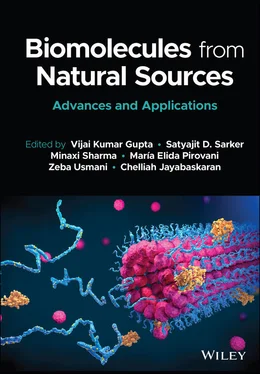Biomolecules from Natural Sources
Здесь есть возможность читать онлайн «Biomolecules from Natural Sources» — ознакомительный отрывок электронной книги совершенно бесплатно, а после прочтения отрывка купить полную версию. В некоторых случаях можно слушать аудио, скачать через торрент в формате fb2 и присутствует краткое содержание. Жанр: unrecognised, на английском языке. Описание произведения, (предисловие) а так же отзывы посетителей доступны на портале библиотеки ЛибКат.
- Название:Biomolecules from Natural Sources
- Автор:
- Жанр:
- Год:неизвестен
- ISBN:нет данных
- Рейтинг книги:5 / 5. Голосов: 1
-
Избранное:Добавить в избранное
- Отзывы:
-
Ваша оценка:
- 100
- 1
- 2
- 3
- 4
- 5
Biomolecules from Natural Sources: краткое содержание, описание и аннотация
Предлагаем к чтению аннотацию, описание, краткое содержание или предисловие (зависит от того, что написал сам автор книги «Biomolecules from Natural Sources»). Если вы не нашли необходимую информацию о книге — напишите в комментариях, мы постараемся отыскать её.
An up-to-date exploration of new and novel biomolecules Biomolecules from Natural Sources: Advances and Applications,
Biomolecules from Natural Sources: Advances and Applications
Natural Sources: Advances and Applications
Biomolecules from Natural Sources — читать онлайн ознакомительный отрывок
Ниже представлен текст книги, разбитый по страницам. Система сохранения места последней прочитанной страницы, позволяет с удобством читать онлайн бесплатно книгу «Biomolecules from Natural Sources», без необходимости каждый раз заново искать на чём Вы остановились. Поставьте закладку, и сможете в любой момент перейти на страницу, на которой закончили чтение.
Интервал:
Закладка:
PHB non-woven patches can be used as a scaffold for tissue regeneration in low-pressure systems. The regenerated vessel had structural and biochemical qualities in common with the native pulmonary artery [250]. PHAs were used in tissue engineering, as antibiotic carriers, and many other medicinal applications [238, 251, 252]. Chen and Wu recently reported that PHAs possesses the biodegradability, biocompatibility and thermo-processibility for not only implant applications but also controlled drug release uses. PHAs show a promising future in pharmaceutical application such as drug delivery, which open a new approach. The many possibilities to tailor-make PHAs for medical implant applications have shown that this class of materials has a bright future as tissue engineering materials [253]. Different types of mutagenesis were applied for changing the substrate specificity, study the catalytic residues and to overproduce the PHAs [254–257].
2.6 Biopolymer Type Number 5: Polyisoprenoides
2.6.1 Natural Rubber
Natural rubber is a cis-1,4-polyisoprene-based biopolymer that has good resilience and damping behavior, but poor chemical resistance and processing capacity. It is collected from the milky secretion (latex) of individual trees, but the Hevea brasiliensis tree is the only important commercial source of natural rubber (sometimes called Pará rubber). Guayuleule is the only other plant under cultivation as a commercial source of rubber ( Parthenium argentatum ). Tyres, computer components, gloves, toys, shoe soles, elastic bands, flippers, erasers and athletic equipment are well-known uses of natural rubber. It is typically used for applications that need resistance to abrasion/wear; elastic resistance and properties that absorb damping or shock. In the production of synthetic rubber, oil is one of the necessary substituents. Natural rubber has enjoyed a rising market share due to the cost of oil and has become an attractive replacement for synthetic rubber. Since natural rubber has better properties compared to other synthetically manufactured rubber, rubber industries usually use it to enhance properties and extend applications of other rubber materials by blending. A very low level of adherence to other materials has also been documented. Natural rubber blended with virgin and recycled ethylene-propylene-diene monomer has been reported by Hayeemasae et al., the curing rate of natural rubber vulcanization was decreased. This was due to the incompatibility of these materials with natural rubber being cured. However, the maximum torque for the recycled material was increased with the addition of both virgin and recycled EPDM and was even higher. This was due to the higher density of cross-linking implemented by EPDM. Natural rubber is an economically important biopolymer with unparalleled performance characteristics, such as high elasticity, durability and efficient heat dispersion [258, 259]. Normal rubber is poly (cis-1,4-isoprene) 300 to 70000 isoperene molecules are coupled to form an irregular structure that cannot crystallize under normal conditions that mediate the amorphous rubber texture. Normal rubber is poly (cis-1,4-isoprene). Currently, the major rubber producing countries are Thailand, Indonesia, Malaysia, India and the People’s Republic of China, which together account for 89% of the world’s 9.33 million tons of the global rubber production.
2.7 Biopolymer Type Number 6: Inorganic Polyesters with Polyphosphate
The polyanhydride present in all living cells is inorganic polyphosphate. Commercial bacterial polyphosphate generation has not yet succceeded for economic reasons. Polyphosphates may have two cell regions as granules within the cytoplasm and related to the inner layer within the periplasmic space, the latter place being primarily related to the use of polyphosphate chemicals such as transport types. The chemical composition is that of a direct inorganic phosphate anhydride that changes in chain length from three to more than 10 3units and consists more often than not of mixtures of distinct atomic sizes. Cations are attached to them. The polyphosphate increases particularly when a supplement lopsidedness occurs within the vicinity of phosphate overabundance. The Mg 2+-dependent polyphosphate kinase that moves the terminal phosphoryl group of ATP to polyphosphate is a second direct mechanism. The enzyme is found in various bacteria that are aerobic, anaerobic and facultative. Harland Wood and his colleagues studied Propionibacterium shermanii polyphosphate kinase and have shown that this monomeric enzyme (Mr 83000) catalyzes a strictly processive reaction [260]. Polyphosphate glucokinase, which makes the formation of glucose 6-phosphate without the intervention of ATP, has a fairly widespread distribution: (P)n + Glucose ~ (P)n-t + Glucose 6-P. The distribution of the enzyme is of taxonomic concern, being limited to a limited group of species (Actinomycetes, Propionibacteria, Micrococci, Brevibacteria and related species). Recently, Wood and colleagues made several major developments with the P. shermanii enzyme [260]. Polyphosphate glucokinase is four times more active in P. shermanii than the ATP glucokinase, illustrating the role of polyphosphate in this organism’s metabolism. Some Acinetobacter species contained in sewage treatment plants using the active sludge process have the capacity, under suitable conditions, to accumulate up to 30% of their biomass of polyphosphate, that is, to be subjected to alternating anaerobiosis and aerobiosis cycles. This property has been put to practical use in the treatment of sewage, thereby allowing a biological method for the removal of phosphate from waste water. Owing to the over-enthusiastic use of fertilizers and detergents containing sodium tripolyphosphate, high phosphate levels in run-off water cause environmental issues with the production of familiar algal (cyanobacterial) blooms on lakes. In microbial cells, the excess phosphate in sewage is accumulated, which can then be removed along with the waste sludge from the process. It has been by van Steveninck and his group that polyphosphates located at the periphery of yeast cells are involved in the transport of sugars through the plasma membrane as energy donors. There are two hexose transport pathways in Kluyveromyces marxianus [261]. In the biosynthesis of cell wall mannoproteins, Kulaev et al. [262] discovered a new mechanism for the synthesis of high polymeric polyphosphate located outside the yeast cytoplasmic membrane and coupled with the conversion of dolichyl diphosphate to dolichyl monophosphate. The conversion of the terminal phosphate to polyphosphate is catalyzed by the special enzyme dolichyl diphosphate:polyphosphate phosphotransferase. There are known polyphosphatases which hydrolyze inorganic phosphate from long-chain polyphosphates. For nucleic acid and carbohydrate metabolism, transport processes and biosynthesis of cell wall polysaccharides, they constitute a pool of what Kulaev has called “activated phosphate” to be drawn on. They also play an essential role in controlling the intracellular concentrations of important metabolites containing phosphorus, including main molecules of the effector. Polyphosphate polyphosphate is an orthophosphate (Pi) residue polymer connected by P–O–P phosphoanhydride bonds. The majority of polyphosphates are stable even at high temperatures in neutral aqueous solutions, unlike long-chained polyphosphates, which are poorly soluble in water. Polyphosphates have a high negative charge density. The analogous structure of the RNA and other polyanions contributes to identical reactivity [263]. Polyphosphate is present in archaea, bacteria, algae, fungi, protists, plants, insects and mammals. Polyphosphate acts as a microbial phosphagen for a number of biochemical reactions, as a buffer against alkalis, as a storage of Ca 2+and as a metal-chelating agent due to its “high energy” bonds similar to those in ATP and its polyanion properties. In signaling and regulatory processes, cell viability and proliferation, pathogen virulence, as a structural component and chemical chaperone, and as a microbial stress reaction modulator, polyphosphate is essential. The majority of research on proteins involved in polyphosphate biosynthesis has focused on microorganisms, namely bacteria, including pathogenic and phosphate bacteria. Some orthologs were described in microorganisms of other taxonomic classes based on these findings. Other enzymes involved in the synthesis of polyphosphate polyphosphate phosphotransferase (EC 2.7.4.20) were associated with the synthesis of a small polyphosphate fraction associated with the vacuolar membrane of Saccharomyces cerevisiae [264]. Polyphosphate, similar to ATP, is composed of high-energy phosphate groups and is likely to be found in prebiotic soil. Polyphosphate is capable of stabilizing and preventing unfolding and aggregation of a wide range of proteins which maintain their competent conformations. Differentiated bacterial mutants with polyphosphate kinase show higher protein damage. Polyphosphate development by human gastrointestinal tract bacteria has been documented to protect the intestinal epithelium from oxidative stress [265]. Polyphosphate is associated with microorganisms in many physiological processes of vital importance, such as multilayer metabolic control, stress responses, resistance to pathogens, etc. Polyphosphate has also recently been documented to be involved in a variety of human health-related biological processes, such as cardiac ischaemia, blood coagulation, apoptosis, and cell death caused by stress [266, 267].
Читать дальшеИнтервал:
Закладка:
Похожие книги на «Biomolecules from Natural Sources»
Представляем Вашему вниманию похожие книги на «Biomolecules from Natural Sources» списком для выбора. Мы отобрали схожую по названию и смыслу литературу в надежде предоставить читателям больше вариантов отыскать новые, интересные, ещё непрочитанные произведения.
Обсуждение, отзывы о книге «Biomolecules from Natural Sources» и просто собственные мнения читателей. Оставьте ваши комментарии, напишите, что Вы думаете о произведении, его смысле или главных героях. Укажите что конкретно понравилось, а что нет, и почему Вы так считаете.


![Джеймс Купер - Пионеры, или У истоков Саскуиханны [The Pioneers, or The sources of the Susquehannah]](/books/395797/dzhejms-kuper-pionery-ili-u-istokov-saskuihanny-t-thumb.webp)









